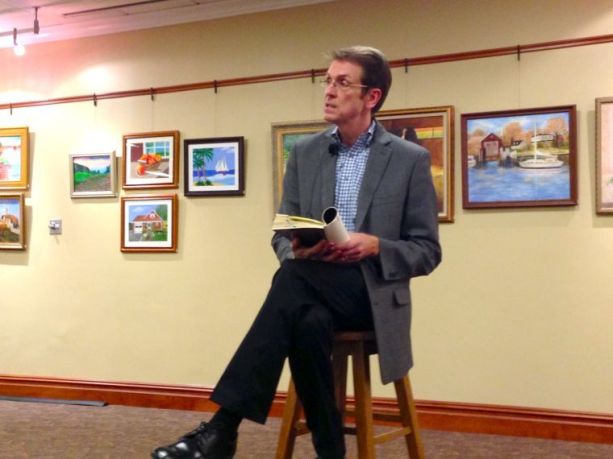Michael Sadowski, a researcher specializing in the relationships between gay, lesbian, bisexual, transgender and questioning youth and the world around them, read selections from his recent book “In a Queer Voice: Journeys of Resilience from Adolescence to Adulthood” on Thursday at the Manhasset Public Library.
Sadowski, the husband of Manhasset High School theater teacher and advisor of the school’s Gay-Straight Alliance Robb Fessler, conducted 12 interviews with LGBTQ students from community-based youth groups in 2002 and 2003 as part of a Harvard University research project, and tracked down six of the subjects six years later to follow where their stories as they grew into adulthood.
“Even though we were just asking questions about their relationships, we heard a lot of stories about risks that these young people faced,” said Sadowski, who after completing his graduate work at Harvard was a faculty member at the Ivy League school, editor of the Harvard Education Letter and has served as vice-chair of the Massachusetts Governor’s Commission on Gay and Lesbian Youth.
“But we also heard that as these young people found the right relationships, their voices emerged in a new way,” Sadowski continued. “These were voices that were starting to proclaim who they were.”
Sadowski said he chose to use the term “queer” in the book’s title as a way of politicizing the issue, “as a means of speaking back and speaking up to the forces that oppress” in describing the evolution of the students with whom he spoke and the emergence of the LGBTQ community’s welcome within society in recent years.
“The adolescents and young adults interviewed for this book give me hope that a new kind of cultural discourse about sexuality is possible, and in many respects, has already begun,” Sadowski said, reading from the book’s conclusion. “In all their stories, I hear a new collective queer voice that makes me optimistic about the future.”
Sadowski first read the struggles of a girl referred to in the book as “Lindsey,” who was ridiculed in school and at home for identifying as bisexual and later more as a lesbian, and resorted to cutting herself and abusing substances as a means of self-expression.
“One of Lindsey’s challenges was that she had trouble communicating what she was feeling,” Sadowski said. “She didn’t feel safe coming out,”
When Lindsey was in 8th grade, she attempted suicide and was put in intensive therapy and rehabilitation programs before beginning high school.
But shortly after she started 9th grade, Lindsey was encouraged to join the school’s Gay-Straight Alliance and found the sense of community that had been lacking in her life previously.
When Sadowski interviewed Lindsey a second time, he learned she had become an advocate for LGBTQ issues and wanted to become a police officer or continue her involvement in public speaking, to give young people the role model she didn’t have as a child.
The second passage Sadowski read from was the story of “Jordan,” a 13-year-old who was born female but grew up identifying as male and had taken to cutting her hair short, wearing baggy flannel shirts and jeans and adopting the pseudonym “Matt.”
Six months prior to their first interview, Jordan told her mother of her gender identity issues and planned on beginning conversion therapy in three years, but told Sadowski the decision left her more depressed and confused than ever.
Jordan told Sadowski she most identified with the summer’s most popular movie character, “Spider-Man 2”’s Peter Parker, who struggles throughout the film with the decision to give up his superhero persona and lead a life considered by most to be “normal.”
“It was a very emotional movie for me,” Sadowski said, reading from the book as Matt. “I found myself crying through it because in the movie he gives up being Spider-Man to make himself happy, and when he does he realizes he’s not happy at all.”
When Sadowski began his second round of interviews, he said he first had trouble contacting Jordan, not wanting to ask her family or the school she attended for leads in catching up.
But Sadowski soon got in touch with her through e-mail, learning she had moved to the south was living with a female partner. She even tried hormone conversion therapy, but stopped after health complications arose.
Sadowski said Jordan was still conflicted about living as a woman, but learned after the book was published that she tried hormone conversion therapy a second time and was more successful.
The final story Sadowski shared was of “Clark,” an African American identifying as gay who was raised in a religious household.
Clark’s family had always been supportive of everything he did in life, but ignored his sexuality even after he came out to them.
Sadowski said Clark grew wary of the silence and was insecure about his family’s reaction, and after some time began seeing a therapist.
But Clark soon realized the therapist he was seeing – the one selected by his family – practiced conversion therapy, gradually asking him more questions about his sexuality and gave him literature about transitioning to a heterosexual lifestyle.
Clark refused to continue going to sessions, but had trouble gauging his family’s reaction because they still ignored the topic of his sexuality, Sadowski said.
“I still think they’re in denial,” Sadowski said, reading Clark’s comments. “I don’t know but they don’t really mention it. It’s kind of like an unspoken thing in my family.”
What helped Clark, Sadowski said, was joining various online communities where homosexuals who were also religious shared their experiences and struggles within a community that often ostracized them. Sadowski said Clark was able to find a balance between his sexuality and his faith.
“I think what the young people teach is that communication is everything, and that’s not just speaking,” Sadowski said. “It’s knowing that you’re heard and in a community in which young people have a place where they can speak their truth and be themselves in all contexts.”

